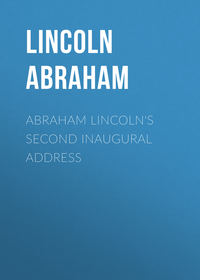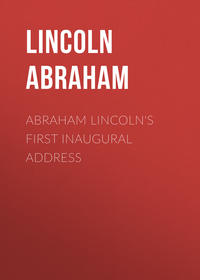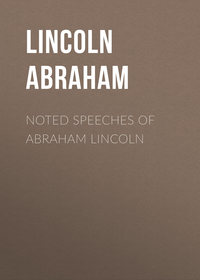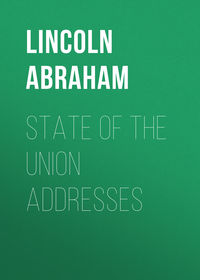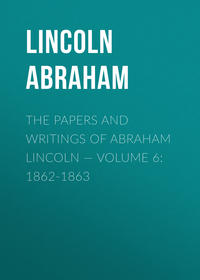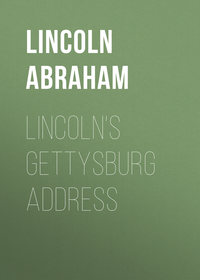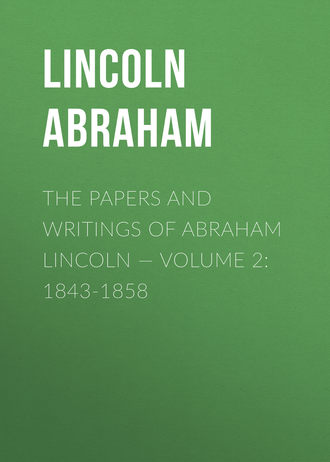 полная версия
полная версияThe Papers And Writings Of Abraham Lincoln — Volume 2: 1843-1858
I had thought the Declaration contemplated the progressive improvement in the condition of all men everywhere; but no, it merely "was adopted for the purpose of justifying the colonists in the eyes of the civilized world in withdrawing their allegiance from the British crown, and dissolving their connection with the mother country." Why, that object having been effected some eighty years ago, the Declaration is of no practical use now — mere rubbish — old wadding left to rot on the battlefield after the victory is won.
I understand you are preparing to celebrate the "Fourth," to-morrow week. What for? The doings of that day had no reference to the present; and quite half of you are not even descendants of those who were referred to at that day. But I suppose you will celebrate, and will even go so far as to read the Declaration. Suppose, after you read it once in the old-fashioned way, you read it once more with Judge Douglas's version. It will then run thus:
"We hold these truths to be self-evident, that all British subjects who were on this continent eighty-one years ago were created equal to all British subjects born and then residing in Great Britain."
And now I appeal to all — to Democrats as well as others — are you really willing that the Declaration shall thus be frittered away? — thus left no more, at most, than an interesting memorial of the dead past? — thus shorn of its vitality and practical value, and left without the germ or even the suggestion of the individual rights of man in it?
But Judge Douglas is especially horrified at the thought of the mixing of blood by the white and black races. Agreed for once — a thousand times agreed. There are white men enough to marry all the white women and black men enough to many all the black women; and so let them be married. On this point we fully agree with the Judge, and when he shall show that his policy is better adapted to prevent amalgamation than ours, we shall drop ours and adopt his. Let us see. In 1850 there were in the United States 405,751 mulattoes. Very few of these are the offspring of whites and free blacks; nearly all have sprung from black slaves and white masters. A separation of the races is the only perfect preventive of amalgamation; but as an immediate separation is impossible, the next best thing is to keep them apart where they are not already together. If white and black people never get together in Kansas, they will never mix blood in Kansas. That is at least one self-evident truth. A few free colored persons may get into the free States, in any event; but their number is too insignificant to amount to much in the way of mixing blood. In 1850 there were in the free States 56,649 mulattoes; but for the most part they were not born there — they came from the slave States, ready made up. In the same year the slave States had 348,874 mulattoes, all of home production. The proportion of free mulattoes to free blacks — the only colored classes in the free States is much greater in the slave than in the free States. It is worthy of note, too, that among the free States those which make the colored man the nearest equal to the white have proportionably the fewest mulattoes, the least of amalgamation. In New Hampshire, the State which goes farthest toward equality between the races, there are just 184 mulattoes, while there are in Virginia — how many do you think? — 79,775, being 23,126 more than in all the free States together.
These statistics show that slavery is the greatest source of amalgamation, and next to it, not the elevation, but the degradation of the free blacks. Yet Judge Douglas dreads the slightest restraints on the spread of slavery, and the slightest human recognition of the negro, as tending horribly to amalgamation!
The very Dred Scott case affords a strong test as to which party most favors amalgamation, the Republicans or the dear Union-saving Democracy. Dred Scott, his wife, and two daughters were all involved in the suit. We desired the court to have held that they were citizens so far at least as to entitle them to a hearing as to whether they were free or not; and then, also, that they were in fact and in law really free. Could we have had our way, the chances of these black girls ever mixing their blood with that of white people would have been diminished at least to the extent that it could not have been without their consent. But Judge Douglas is delighted to have them decided to be slaves, and not human enough to have a hearing, even if they were free, and thus left subject to the forced concubinage of their masters, and liable to become the mothers of mulattoes in spite of themselves: the very state of case that produces nine tenths of all the mulattoes all the mixing of blood in the nation.
Of course, I state this case as an illustration only, not meaning to say or intimate that the master of Dred Scott and his family, or any more than a percentage of masters generally, are inclined to exercise this particular power which they hold over their female slaves.
I have said that the separation of the races is the only perfect preventive of amalgamation. I have no right to say all the members of the Republican party are in favor of this, nor to say that as a party they are in favor of it. There is nothing in their platform directly on the subject. But I can say a very large proportion of its members are for it, and that the chief plank in their platform — opposition to the spread of slavery — is most favorable to that separation.
Such separation, if ever effected at all, must be effected by colonization; and no political party, as such, is now doing anything directly for colonization. Party operations at present only favor or retard colonization incidentally. The enterprise is a difficult one; but "where there is a will there is a way," and what colonization needs most is a hearty will. Will springs from the two elements of moral sense and self-interest. Let us be brought to believe it is morally right, and at the same time favorable to, or at least not against, our interest to transfer the African to his native clime, and we shall find a way to do it, however great the task may be. The children of Israel, to such numbers as to include four hundred thousand fighting men, went out of Egyptian bondage in a body.
How differently the respective courses of the Democratic and Republican parties incidentally, bear on the question of forming a will — a public sentiment — for colonization, is easy to see. The Republicans inculcate, with whatever of ability they can, that the negro is a man, that his bondage is cruelly wrong, and that the field of his oppression ought not to be enlarged. The Democrats deny his manhood; deny, or dwarf to insignificance, the wrong of his bondage; so far as possible crush all sympathy for him, and cultivate and excite hatred and disgust against him; compliment themselves as Union-savers for doing so; and call the indefinite outspreading of his bondage "a sacred right of self-government."
The plainest print cannot be read through a gold eagle; and it will be ever hard to find many men who will send a slave to Liberia, and pay his passage, while they can send him to a new country — Kansas, for instance — and sell him for fifteen hundred dollars, and the rise.
TO WILLIAM GRIMES
SPRINGFIELD, ILLINOIS, August, 1857DEAR SIR: — Yours of the 14th is received, and I am much obliged for the legal information you give.
You can scarcely be more anxious than I that the next election in Iowa should result in favor of the Republicans. I lost nearly all the working part of last year, giving my time to the canvass; and I am altogether too poor to lose two years together. I am engaged in a suit in the United States Court at Chicago, in which the Rock Island Bridge Company is a party. The trial is to commence on the 8th of September, and probably will last two or three weeks. During the trial it is not improbable that all hands may come over and take a look at the bridge, and, if it were possible to make it hit right, I could then speak at Davenport. My courts go right on without cessation till late in November. Write me again, pointing out the more striking points of difference between your old and new constitutions, and also whether Democratic and Republican party lines were drawn in the adoption of it, and which were for and which were against it. If, by possibility, I could get over among you it might be of some advantage to know these things in advance.
Yours very truly,
A. LINCOLN.
ARGUMENT IN THE ROCK ISLAND BRIDGE CASE
(From the Daily Press of Chicago, Sept. 24, 1857.)Hurd et al. vs Railroad Bridge Co.
United States Circuit Court, Hon. John McLean, Presiding Judge.
13th day, Tuesday, Sept. 22, 1857.
Mr. A. Lincoln addressed the jury. He said he did not purpose to assail anybody, that he expected to grow earnest as he proceeded but not ill-natured. "There is some conflict of testimony in the case," he said, "but one quarter of such a number of witnesses seldom agree, and even if all were on one side some discrepancy might be expected. We are to try and reconcile them, and to believe that they are not intentionally erroneous as long as we can." He had no prejudice, he said, against steamboats or steamboat men nor any against St. Louis, for he supposed they went about this matter as other people would do in their situation. "St. Louis," he continued, "as a commercial place may desire that this bridge should not stand, as it is adverse to her commerce, diverting a portion of it from the river; and it may be that she supposes that the additional cost of railroad transportation upon the productions of Iowa will force them to go to St. Louis if this bridge is removed. The meetings in St. Louis are connected with this case only as some witnesses are in it, and thus has some prejudice added color to their testimony." The last thing that would be pleasing to him, Mr. Lincoln said, would be to have one of these great channels, extending almost from where it never freezes to where it never thaws, blocked up, but there is a travel from east to west whose demands are not less important than those of the river. It is growing larger and larger, building up new countries with a rapidity never before seen in the history of the world. He alluded to the astonishing growth of Illinois, having grown within his memory to a population of a million and a half; to Iowa and the other young rising communities of the Northwest.
"This current of travel," said he, "has its rights as well as that of north and south. If the river had not the advantage in priority and legislation we could enter into free competition with it and we could surpass it. This particular railroad line has a great importance and the statement of its business during a little less than a year shows this importance. It is in evidence that from September 8, 1856, to August 8, 1857, 12,586 freight cars and 74,179 passengers passed over this bridge. Navigation was closed four days short of four months last year, and during this time while the river was of no use this road and bridge were valuable. There is, too, a considerable portion of time when floating or thin ice makes the river useless while the bridge is as useful as ever. This shows that this bridge must be treated with respect in this court and is not to be kicked about with contempt. The other day Judge Wead alluded to the strike of the contending interest and even a dissolution of the Union. The proper mode for all parties in this affair is to 'live and let live,' and then we will find a cessation of this trouble about the bridge. What mood were the steamboat men in when this bridge was burned? Why, there was a shouting and ringing of bells and whistling on all the boats as it fell. It was a jubilee, a greater celebration than follows an excited election. The first thing I will proceed to is the record of Mr. Gurney and the complaint of Judge Wead that the record did not extend back over all the time from the completion of the bridge. The principal part of the navigation after the bridge was burned passed through the span. When the bridge was repaired and the boats were a second time confined to the draw it was provided that this record should be kept. That is the simple history of that book.
"From April 19th, 1856, to May 6th — seventeen days — there were twenty accidents and all the time since then there have been but twenty hits, including seven accidents, so that the dangers of this place are tapering off and as the boatmen get cool the accidents get less. We may soon expect if this ratio is kept up that there will be no accidents at all.
"Judge Wead said, while admitting that the floats went straight through, there was a difference between a float and a boat, but I do not remember that he indulged us with an argument in support of this statement. Is it because there is a difference in size? Will not a small body and a large one float the same way under the same influence? True a flatboat will float faster than an egg shell and the egg shell might be blown away by the wind, but if under the same influence they would go the same way. Logs, floats, boards, various things the witnesses say all show the same current. Then is not this test reliable? At all depths too the direction of the current is the same. A series of these floats would make a line as long as a boat and would show any influence upon any part and all parts of the boat.
"I will now speak of the angular position of the piers. What is the amount of the angle? The course of the river is a curve and the pier is straight. If a line is produced from the upper end of the long pier straight with the pier to a distance of 350 feet, and a line is drawn from a point in the channel opposite this point to the head of the pier, Colonel Nason says they will form an angle of twenty degrees. But the angle if measured at the pier is seven degrees; that is, we would have to move the pier seven degrees to make it exactly straight with the current. Would that make the navigation better or worse? The witnesses of the plaintiff seem to think it was only necessary to say that the pier formed an angle with the current and that settled the matter. Our more careful and accurate witnesses say that, though they had been accustomed to seeing the piers placed straight with the current, yet they could see that here the current had been made straight by us in having made this slight angle; that the water now runs just right, that it is straight and cannot be improved. They think that if the pier was changed the eddy would be divided and the navigation improved.
"I am not now going to discuss the question what is a material obstruction. We do not greatly differ about the law. The cases produced here are, I suppose, proper to be taken into consideration by the court in instructing a jury. Some of them I think are not exactly in point, but I am still willing to trust his honor, Judge McLean, and take his instructions as law. What is reasonable skill and care? This is a thing of which the jury are to judge. I differ from the other side when it says that they are bound to exercise no more care than was taken before the building of the bridge. If we are allowed by the Legislature to build the bridge which will require them to do more than before, when a pilot comes along, it is unreasonable for him to dash on heedless of this structure which has been legally put there. The Afton came there on the 5th and lay at Rock Island until next morning. When a boat lies up the pilot has a holiday, and would not any of these jurors have then gone around to the bridge and gotten acquainted with the place? Pilot Parker has shown here that he does not understand the draw. I heard him say that the fall from the head to the foot of the pier was four feet; he needs information. He could have gone there that day and seen there was no such fall. He should have discarded passion and the chances are that he would have had no disaster at all. He was bound to make himself acquainted with the place.
"McCammon says that the current and the swell coming from the long pier drove her against the long pier. In other words drove her toward the very pier from which the current came! It is an absurdity, an impossibility. The only recollection I can find for this contradiction is in a current which White says strikes out from the long pier and then like a ram's horn turns back, and this might have acted somehow in this manner.
"It is agreed by all that the plaintiff's boat was destroyed and that it was destroyed upon the head of the short pier; that she moved from the channel where she was with her bow above the head of the long pier, till she struck the short one, swung around under the bridge and there was crowded and destroyed.
"I shall try to prove that the average velocity of the current through the draw with the boat in it should be five and a half miles an hour; that it is slowest at the head of the pier and swiftest at the foot of the pier. Their lowest estimate in evidence is six miles an hour, their highest twelve miles. This was the testimony of men who had made no experiment, only conjecture. We have adopted the most exact means. The water runs swiftest in high water and we have taken the point of nine feet above low water. The water when the Afton was lost was seven feet above low water, or at least a foot lower than our time. Brayton and his assistants timed the instruments, the best instruments known in measuring currents. They timed them under various circumstances and they found the current five miles an hour and no more. They found that the water at the upper end ran slower than five miles; that below it was swifter than five miles, but that the average was five miles. Shall men who have taken no care, who conjecture, some of whom speak of twenty miles an hour, be believed against those who have had such a favorable and well improved opportunity? They should not even qualify the result. Several men have given their opinion as to the distance of the steamboat Carson, and I suppose if one should go and measure that distance you would believe him in preference to all of them.
"These measurements were made when the boat was not in the draw. It has been ascertained what is the area of the cross section of this stream and the area of the face of the piers, and the engineers say that the piers being put there will increase the current proportionally as the space is decreased. So with the boat in the draw. The depth of the channel was twenty-two feet, the width one hundred and sixteen feet; multiply these and you have the square-feet across the water of the draw, viz.: 2552 feet. The Afton was 35 feet wide and drew 5 feet, making a fourteenth of the sum. Now, one-fourteenth of five miles is five-fourteenths of one mile — about one third of a mile — the increase of the current. We will call the current five and a half miles per hour. The next thing I will try to prove is that the plaintiff's (?) boat had power to run six miles an hour in that current. It had been testified that she was a strong, swift boat, able to run eight miles an hour up stream in a current of four miles an hour, and fifteen miles down stream. Strike the average and you will find what is her average — about eleven and a half miles. Take the five and a half miles which is the speed of the current in the draw and it leaves the power of that boat in that draw at six miles an hour, 528 feet per minute and 8 4/5 feet to the second.
"Next I propose to show that there are no cross currents. I know their witnesses say that there are cross currents — that, as one witness says, there were three cross currents and two eddies; so far as mere statement, without experiment, and mingled with mistakes, can go, they have proved. But can these men's testimony be compared with the nice, exact, thorough experiments of our witnesses? Can you believe that these floats go across the currents? It is inconceivable that they could not have discovered every possible current. How do boats find currents that floats cannot discover? We assume the position then that those cross currents are not there. My next proposition is that the Afton passed between the S. B. Carson and the Iowa shore. That is undisputed.
"Next I shall show that she struck first the short pier, then the long pier, then the short one again and there she stopped." Mr. Lincoln then cited the testimony of eighteen witnesses on this point.
"How did the boat strike when she went in? Here is an endless variety of opinion. But ten of them say what pier she struck; three of them testify that she struck first the short, then the long and then the short for the last time. None of the rest substantially contradict this. I assume that these men have got the truth because I believe it an established fact. My next proposition is that after she struck the short and long pier and before she got back to the short pier the boat got right with her bow up. So says the pilot Parker — that he got her through until her starboard wheel passed the short pier. This would make her head about even with the head of the long pier. He says her head was as high or higher than the head of the long pier. Other witnesses confirmed this one. The final stroke was in the splash door aft the wheel. Witnesses differ, but the majority say that she struck thus."
Court adjourned.
14th day, Wednesday, Sept. 23, 1857.
Mr. A. LINCOLN resumed. He said he should conclude as soon as possible. He said the colored map of the plaintiff which was brought in during one stage of the trial showed itself that the cross currents alleged did not exist. That the current as represented would drive an ascending boat to the long pier but not to the short pier, as they urge. He explained from a model of a boat where the splash door is, just behind the wheel. The boat struck on the lower shoulder of the short pier as she swung around in the splash door; then as she went on around she struck the point or end of the pier, where she rested. "Her engineers," said Mr. Lincoln, "say the starboard wheel then was rushing around rapidly. Then the boat must have struck the upper point of the pier so far back as not to disturb the wheel. It is forty feet from the stern of the Afton to the splash door, and thus it appears that she had but forty feet to go to clear the pier. How was it that the Afton with all her power flanked over from the channel to the short pier without moving one foot ahead? Suppose she was in the middle of the draw, her wheel would have been 31 feet from the short pier. The reason she went over thus is her starboard wheel was not working. I shall try to establish the fact that the wheel was not running and that after she struck she went ahead strong on this same wheel. Upon the last point the witnesses agree, that the starboard wheel was running after she struck, and no witnesses say that it was running while she was out in the draw flanking over."
Mr. Lincoln read from the testimonies of various witnesses to prove that the starboard wheel was not working while the Afton was out in the stream.
"Other witnesses show that the captain said something of the machinery of the wheel, and the inference is that he knew the wheel was not working. The fact is undisputed that she did not move one inch ahead while she was moving this 31 feet sideways. There is evidence proving that the current there is only five miles an hour, and the only explanation is that her power was not all used — that only one wheel was working. The pilot says he ordered the engineers to back her up. The engineers differ from him and said they kept on going ahead. The bow was so swung that the current pressed it over; the pilot pressed the stern over with the rudder, though not so fast but that the bow gained on it, and only one wheel being in motion the boat nearly stood still so far as motion up and down is concerned, and thus she was thrown upon this pier. The Afton came into the draw after she had just passed the Carson, and as the Carson no doubt kept the true course the Afton going around her got out of the proper way, got across the current into the eddy which is west of a straight line drawn down from the long pier, was compelled to resort to these changes of wheels, which she did not do with sufficient adroitness to save her. Was it not her own fault that she entered wrong, so far wrong that she never got right? Is the defence to blame for that?


